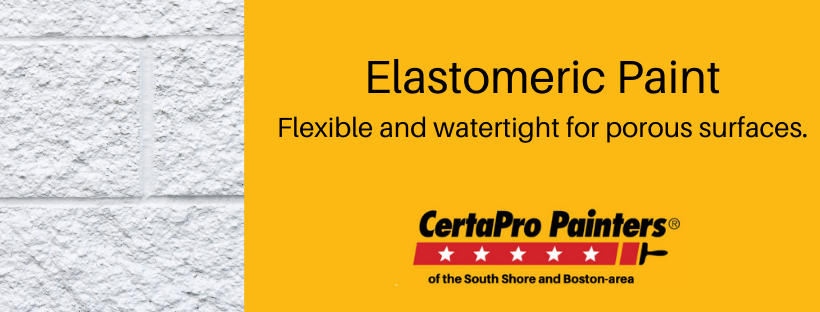
Elastomeric Paint – flexible paint for porous surfaces
Posted on January 23, 2022
What is elastomeric paint?
Elastomeric paint is a coating that forms a barrier against moisture and is flexible.
It’s used to protect masonry surfaces, and while it’s applied just like regular liquid paint, it dries to a flexible and watertight coating.
This is a paint that can stretch and return to its original form – it’s the yoga pants of paint!
Why use elastomeric paint?
Watertight:

Elastomeric paint is watertight, creates a barrier that moisture cannot penetrate, and works exceptionally well on porous surfaces like masonry bricks, poured concrete, and stucco.
Durability:
Elastomeric paint lasts a long time – longer than ordinary paints. It’s perfect for the extreme temperature shifts in the Boston area and because it’s also flexible, cracks in the paint will not occur nearly as often as with ordinary paint.
Flexible:
Elastomeric paint is stretchy, making it flex when the structure inevitably shifts. This helps prevent it from cracking like ordinary paint does, especially during extreme temperatures.
Great coverage:
Elastomeric paint is about 7x thicker than ordinary paint so coverage is fantastic.

Porous surfaces need protection:
Concrete block, stucco, and brick are all porous and need protection from an elastomeric paint coating.
Our harsh Boston Climate:
Ordinary paint will crack during the temperature extremes of the Boston area. Elastomeric paint is flexible so it’s much less likely to crack and become damaged by the driving rain, snow and ice our coastal area experiences.
Drawbacks to Using Elastomeric Paint:
Cost:
Elastomeric paint is about 50% more expensive than regular paint. But because it’s so much more durable, you will save in the long run by using it.
Weight:
If you already have several coats of paint on your stucco or masonry, since elastomeric paint is heavy, it could cause the undercoats of paint to start peeling off with the elastomeric paint layer as well.
Not easy to apply:
It’s not as easy to apply elastomeric paint as it is to apply regular paint. A DIYer can handle this project, but only by following the manufacturer’s instructions carefully – otherwise, you could end up with a “lumpy” paint job.
Questions about using elastomeric paint? We can help!
If you have any questions about elastomeric paint, just email [email protected] – we’re happy to answer your questions even if you’re doing the painting yourself.
If you need a quote from our Commercial Team who applies elastomeric paint across New England, call or text us at (781) 422-1018 or email us at [email protected].
< BACK TO OUR INDEX OF ARTICLES, TIPS, AND ADVICE
You also might like to read:
Painting in an owner-occupied community (communication is key!)
Painting commercial projects at night and on weekends at no extra charge.





